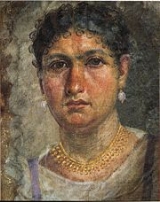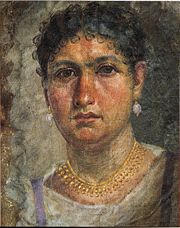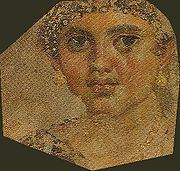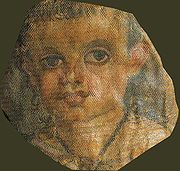
Tomb of Aline
Encyclopedia
The Tomb of Aline is an ancient Egypt
ian grave
from the time of Tiberius
or Hadrian
, excavated at Hawara
in 1892.
s. In this general context, the German archaeologist
Richard von Kaufmann undertook a short campaign of excavations at Haware in March 1892; his most important find was the so-called Tomb of Aline. A shaft led to a simple mud-brick-lined pit of 2.8 by 3.5 m which contained eight mummies
. Three were undecorated, two had paper masks and three were adorned with mummy portraits
. The grave had no superstructure.
The three mummies with painted portraits lay at the bottom; they were those of the woman Aline and of two female children. The two masked mummies lay at right angles on top of them; they were those of a man and of a somewhat older girl. The two undecorated mummies, in turn, lay on top, again at right angles. On the mummies of the man, the woman and the three girls, the wrapping had been additionally secured with clay sealings, using different sealstones
. One depicted Heracles
fighting the Nemean lion
, the others heads. Not all sealings are preserved. The gravegoods included a clay pot with a spray of flowers, as is typical for such graves. There was also a roughly hewn stele
bearing the following Greek
inscription:
The grave was named after this inscription. Scholarship assumes that Aline is the woman buried in the tomb and equipped with a mummy portrait. Further, it is believed that the man was her husband and the girls her daughters. As the ages and sexes of the undecorated mummies are not known, they cannot be similarly attributed. The separation of the date in the inscription in two parts, resulting from the insertion of Aline's age in the middle, is unusual. Since it was common in Roman Egypt to count the year from the accession of the current ruler, the grave can be dated, in conjunction with the portrait's hairstyle, quite securely to one of two possible dates. It is usually taken to be from the tenth year of the reign of Tiberius
, i.e. 24 AD. The same hairstyle became popular once more a century later, so that the 10th year of Hadrian
's reign (AD 107) is also a possibility, but most scholars prefer the earlier date. Further arguments in favour of the later date include the fine painting style and use of hatching, both typical of the 2nd century AD, the lilac tones of the garments, the depiction of the woman as rather well-fed, as well as the hair and beard of the man. It remains unclear when the mummies were deposited and whether all died within the same generation.
Today, the finds from the Grave are at the Egyptian Museum
, Berlin
. Part of them is on display in the Altes Museum
.
 The portrait of Aline was painted in tempera
The portrait of Aline was painted in tempera
on linen, as were those of the two girls. It has a height of 40 and a width 32.5 cm. Below the painted cloth, scraps of linen pressed onto the mummy's face were used to provide an even surface, so that the portrait is nearly flat. Some of the portraits were painted before the death of their subject, but in Aline's case, where it is actually painted on the end of the mummy wrapping, it appears to have been produced after death, perhaps based on a previously prepared portrait. As is common for mummy portraits, the painting produces the impression of three-dimensional depth, a relatively recent feature in Egyptian art and due to Graeco-Roman influences. Frontal depictions of human faces had also been unusual throughout most of the history of Egyptian art. The wavy hairstyle with a central parting is painted simply, but carefully. The small ringlets above the forehead are striking. The face appears full, but not fat. It conveys the impression that this woman, who belonged to the middle or upper levels of Egyptian society, had led a good life. Her simple jewellery is carefully painted. The depiction of the necklace made of gilded plaster, added to the portrait. Aline wears a white tunic
a or chiton
, thin lilac bands (clavus
) run across her shoulder. The colours are warm. The sad, wistful gaze is typical of mummy portraits. Altogether, it is a masterful portrait of a middle-aged woman.
Aline is one of the exceedingly rare cases where we know the name and appearance of a person from antiquity who did not belong to the ruling classes and is not otherwise known from literature.
 The two mummies of the younger girls have not been opened as yet. In the early 1990s they were examined by using modern techniques. The portrait of the older girl, probably the middle one among the three daughters of Aline and her husband, resembles that of her mother. Since it is still attached to her mummy, it is less clearly visible at present; additionally, it has been attached somewhat too far to the right of the window-like opening in the wrapping. As with the other children and the man, her name is unknown. She wears valuable but simple jewellery and has a ringlet hairstyle.
The two mummies of the younger girls have not been opened as yet. In the early 1990s they were examined by using modern techniques. The portrait of the older girl, probably the middle one among the three daughters of Aline and her husband, resembles that of her mother. Since it is still attached to her mummy, it is less clearly visible at present; additionally, it has been attached somewhat too far to the right of the window-like opening in the wrapping. As with the other children and the man, her name is unknown. She wears valuable but simple jewellery and has a ringlet hairstyle.
 For a long time, scholarship considered the younger girl as a boy. Recent research definitely proves that the chubby-cheeked child with ears sticking out is a girl. Around her neck is a leather band with a lunula
For a long time, scholarship considered the younger girl as a boy. Recent research definitely proves that the chubby-cheeked child with ears sticking out is a girl. Around her neck is a leather band with a lunula
pendant, an apotropaic amulet
commonly worn by women or girls. Her chiton
is violet in colour, a feature exclusive to females. Further it has partially fallen, exposing her left shoulder, an attribute of the goddess Aphrodite
, aimed to underline erotic attraction. It is commonly used on the mummy portraits of women and even young girls. Thus, the child's gender is indubitably female.
Ancient Egypt
Ancient Egypt was an ancient civilization of Northeastern Africa, concentrated along the lower reaches of the Nile River in what is now the modern country of Egypt. Egyptian civilization coalesced around 3150 BC with the political unification of Upper and Lower Egypt under the first pharaoh...
ian grave
Grave (burial)
A grave is a location where a dead body is buried. Graves are usually located in special areas set aside for the purpose of burial, such as graveyards or cemeteries....
from the time of Tiberius
Tiberius
Tiberius , was Roman Emperor from 14 AD to 37 AD. Tiberius was by birth a Claudian, son of Tiberius Claudius Nero and Livia Drusilla. His mother divorced Nero and married Augustus in 39 BC, making him a step-son of Octavian...
or Hadrian
Hadrian
Hadrian , was Roman Emperor from 117 to 138. He is best known for building Hadrian's Wall, which marked the northern limit of Roman Britain. In Rome, he re-built the Pantheon and constructed the Temple of Venus and Roma. In addition to being emperor, Hadrian was a humanist and was philhellene in...
, excavated at Hawara
Hawara
Hawara is an archaeological site of Ancient Egypt, south of the site of Crocodilopolis at the entrance to the depression of the Fayyum oasis. The first excavations at the site were made by Karl Lepsius, in 1843...
in 1892.
Find conditions, finds, date
In the second half of the 19th century, the increasing interest in Egyptian history, culture and art led to a veritable contest between various European nations, all aiming to secure ancient finds of the best possible quality (and quantity) for their national museumMuseum
A museum is an institution that cares for a collection of artifacts and other objects of scientific, artistic, cultural, or historical importance and makes them available for public viewing through exhibits that may be permanent or temporary. Most large museums are located in major cities...
s. In this general context, the German archaeologist
Archaeology
Archaeology, or archeology , is the study of human society, primarily through the recovery and analysis of the material culture and environmental data that they have left behind, which includes artifacts, architecture, biofacts and cultural landscapes...
Richard von Kaufmann undertook a short campaign of excavations at Haware in March 1892; his most important find was the so-called Tomb of Aline. A shaft led to a simple mud-brick-lined pit of 2.8 by 3.5 m which contained eight mummies
Mummy
A mummy is a body, human or animal, whose skin and organs have been preserved by either intentional or incidental exposure to chemicals, extreme coldness , very low humidity, or lack of air when bodies are submerged in bogs, so that the recovered body will not decay further if kept in cool and dry...
. Three were undecorated, two had paper masks and three were adorned with mummy portraits
Fayum mummy portraits
Mummy portraits or Fayum mummy portraits is the modern term given to a type of naturalistic painted portraits on wooden boards attached to mummies from the Coptic period. They belong to the tradition of panel painting, one of the most highly regarded forms of art in the Classical world...
. The grave had no superstructure.
The three mummies with painted portraits lay at the bottom; they were those of the woman Aline and of two female children. The two masked mummies lay at right angles on top of them; they were those of a man and of a somewhat older girl. The two undecorated mummies, in turn, lay on top, again at right angles. On the mummies of the man, the woman and the three girls, the wrapping had been additionally secured with clay sealings, using different sealstones
Seal (device)
A seal can be a figure impressed in wax, clay, or some other medium, or embossed on paper, with the purpose of authenticating a document ; but the term can also mean the device for making such impressions, being essentially a mould with the mirror image of the design carved in sunken- relief or...
. One depicted Heracles
Heracles
Heracles ,born Alcaeus or Alcides , was a divine hero in Greek mythology, the son of Zeus and Alcmene, foster son of Amphitryon and great-grandson of Perseus...
fighting the Nemean lion
Nemean Lion
The Nemean lion was a vicious monster in Greek mythology that lived at Nemea. It was eventually killed by Heracles. It could not be killed with mortal weapons because its golden fur was impervious to attack...
, the others heads. Not all sealings are preserved. The gravegoods included a clay pot with a spray of flowers, as is typical for such graves. There was also a roughly hewn stele
Stele
A stele , also stela , is a stone or wooden slab, generally taller than it is wide, erected for funerals or commemorative purposes, most usually decorated with the names and titles of the deceased or living — inscribed, carved in relief , or painted onto the slab...
bearing the following Greek
Greek language
Greek is an independent branch of the Indo-European family of languages. Native to the southern Balkans, it has the longest documented history of any Indo-European language, spanning 34 centuries of written records. Its writing system has been the Greek alphabet for the majority of its history;...
inscription:
| Greek | English |
|---|---|
ΑΛΙΝΗΙ Η ΚΑΙ ΤΈΝΩC ΗΡΩΔΟΥ ΧΡΉC ΤΗ ΧΑΙΡΕ ΠΟΛΛΑ ΕΤΟΥC Ι ΛΕ Λ ΜΕΣΟΡΉ Ζ |
Aline also called Tenos daughter of Herodes much loved died in year 10, age 35 years on the 7th of Mesore |
The grave was named after this inscription. Scholarship assumes that Aline is the woman buried in the tomb and equipped with a mummy portrait. Further, it is believed that the man was her husband and the girls her daughters. As the ages and sexes of the undecorated mummies are not known, they cannot be similarly attributed. The separation of the date in the inscription in two parts, resulting from the insertion of Aline's age in the middle, is unusual. Since it was common in Roman Egypt to count the year from the accession of the current ruler, the grave can be dated, in conjunction with the portrait's hairstyle, quite securely to one of two possible dates. It is usually taken to be from the tenth year of the reign of Tiberius
Tiberius
Tiberius , was Roman Emperor from 14 AD to 37 AD. Tiberius was by birth a Claudian, son of Tiberius Claudius Nero and Livia Drusilla. His mother divorced Nero and married Augustus in 39 BC, making him a step-son of Octavian...
, i.e. 24 AD. The same hairstyle became popular once more a century later, so that the 10th year of Hadrian
Hadrian
Hadrian , was Roman Emperor from 117 to 138. He is best known for building Hadrian's Wall, which marked the northern limit of Roman Britain. In Rome, he re-built the Pantheon and constructed the Temple of Venus and Roma. In addition to being emperor, Hadrian was a humanist and was philhellene in...
's reign (AD 107) is also a possibility, but most scholars prefer the earlier date. Further arguments in favour of the later date include the fine painting style and use of hatching, both typical of the 2nd century AD, the lilac tones of the garments, the depiction of the woman as rather well-fed, as well as the hair and beard of the man. It remains unclear when the mummies were deposited and whether all died within the same generation.
Today, the finds from the Grave are at the Egyptian Museum
Egyptian Museum of Berlin
The Egyptian Museum of Berlin is home to one of the world's most important collections of Ancient Egyptian artifacts.The collection is part of the Neues Museum.-History:...
, Berlin
Berlin
Berlin is the capital city of Germany and is one of the 16 states of Germany. With a population of 3.45 million people, Berlin is Germany's largest city. It is the second most populous city proper and the seventh most populous urban area in the European Union...
. Part of them is on display in the Altes Museum
Altes Museum
The Altes Museum , is one of several internationally renowned museums on Museum Island in Berlin, Germany. Since restoration work in 1966, it houses the Antikensammlung of the Berlin State Museums...
.
Aline

Tempera
Tempera, also known as egg tempera, is a permanent fast-drying painting medium consisting of colored pigment mixed with a water-soluble binder medium . Tempera also refers to the paintings done in this medium. Tempera paintings are very long lasting, and examples from the 1st centuries AD still exist...
on linen, as were those of the two girls. It has a height of 40 and a width 32.5 cm. Below the painted cloth, scraps of linen pressed onto the mummy's face were used to provide an even surface, so that the portrait is nearly flat. Some of the portraits were painted before the death of their subject, but in Aline's case, where it is actually painted on the end of the mummy wrapping, it appears to have been produced after death, perhaps based on a previously prepared portrait. As is common for mummy portraits, the painting produces the impression of three-dimensional depth, a relatively recent feature in Egyptian art and due to Graeco-Roman influences. Frontal depictions of human faces had also been unusual throughout most of the history of Egyptian art. The wavy hairstyle with a central parting is painted simply, but carefully. The small ringlets above the forehead are striking. The face appears full, but not fat. It conveys the impression that this woman, who belonged to the middle or upper levels of Egyptian society, had led a good life. Her simple jewellery is carefully painted. The depiction of the necklace made of gilded plaster, added to the portrait. Aline wears a white tunic
Tunic
A tunic is any of several types of clothing for the body, of various lengths reaching from the shoulders to somewhere between the hips and the ankles...
a or chiton
Chiton (costume)
A chiton was a form of clothing worn by men and women in Ancient Greece, from the Archaic period to the Hellenistic period ....
, thin lilac bands (clavus
Laticlave
In Ancient Roman regalia, a laticlave, or clavus, was a broad stripe or band of purple on the fore part of the tunic, worn by senators as an emblem of office, from which the difference of the tunica angusticlavia, and laticlavia....
) run across her shoulder. The colours are warm. The sad, wistful gaze is typical of mummy portraits. Altogether, it is a masterful portrait of a middle-aged woman.
Aline is one of the exceedingly rare cases where we know the name and appearance of a person from antiquity who did not belong to the ruling classes and is not otherwise known from literature.
Children


Lunula
The word lunula means little moon and commonly refers to:* Lunula * Two round brackets and the text between them* A type of necklace shaped like a crescent moon...
pendant, an apotropaic amulet
Amulet
An amulet, similar to a talisman , is any object intended to bring good luck or protection to its owner.Potential amulets include gems, especially engraved gems, statues, coins, drawings, pendants, rings, plants and animals; even words said in certain occasions—for example: vade retro satana—, to...
commonly worn by women or girls. Her chiton
Chiton (costume)
A chiton was a form of clothing worn by men and women in Ancient Greece, from the Archaic period to the Hellenistic period ....
is violet in colour, a feature exclusive to females. Further it has partially fallen, exposing her left shoulder, an attribute of the goddess Aphrodite
Aphrodite
Aphrodite is the Greek goddess of love, beauty, pleasure, and procreation.Her Roman equivalent is the goddess .Historically, her cult in Greece was imported from, or influenced by, the cult of Astarte in Phoenicia....
, aimed to underline erotic attraction. It is commonly used on the mummy portraits of women and even young girls. Thus, the child's gender is indubitably female.

